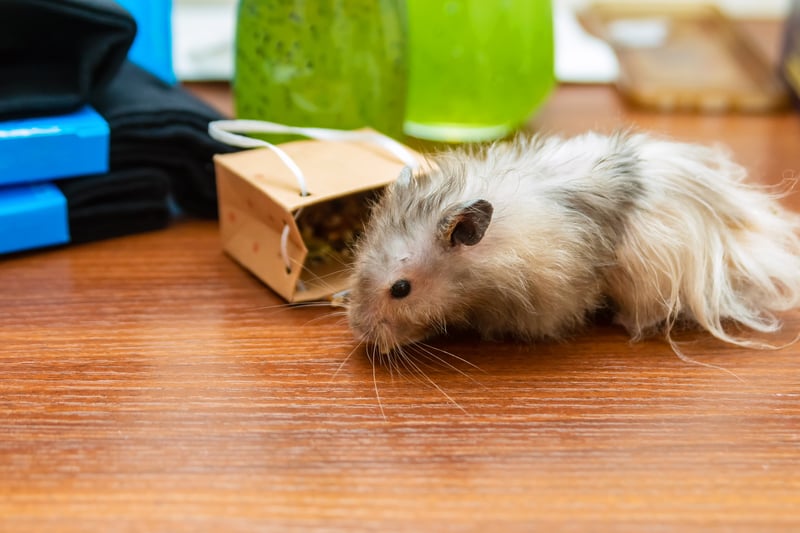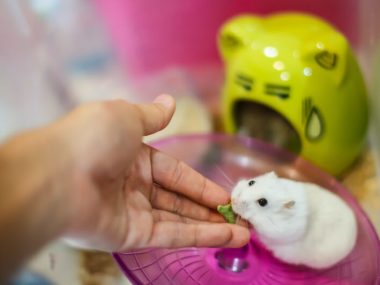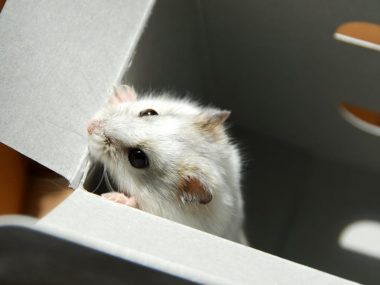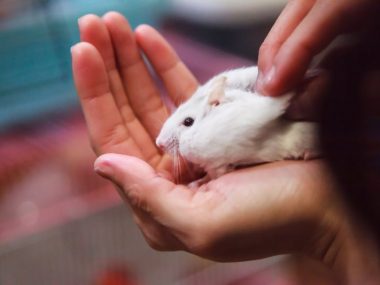While most hamsters are typically marketed as low-maintenance pets ideal for first-time pet owners, this is not true for all hamster species. Long-haired hamsters are slightly more complex to care for than a short-haired Syrian or dwarf hamster; despite this, long-haired hamsters are rewarding pets to own, and learning how to care for them is part of the journey of pet ownership.
Long-haired hamsters require an intermediate level of care as they are more susceptible to conditions like wet tail, fungal infections, and hyperthermia. Caring for a long-haired hamster requires a good diet, a high-quality sandbox, a low-stress environment, and plenty of cage space.
Learning how to care for your long-haired hamster is a fascinating process that provides you with ample opportunity to gain insights into your exotic pet. Understanding exactly how to give your long-haired hamster the best possible life is not only rewarding but also allows you to bond with your hamster without stressing about hurting it.
Table of Contents
What Type Of Hamster Is A Long Haired?
Long-haired hamsters are a product of an autosomal recessive gene mutation that spontaneously occurred in pet hamsters. Male long-haired hamsters typically have longer, fuzzier coats than females due to their elevated testosterone levels.
Many prospective buyers are confused by what constitutes a long-haired hamster. Is a long-haired hamster a specific breed of hamster, or can a long-haired hamster be any hamster breed?
Many people, particularly unknowledgeable or unscrupulous pet shops, may falsely advertise a hamster as long-haired; it is common to see hamsters being marketed as:
- Long-haired teddy bear hamster
- Long-haired dwarf hamster
- Siberian long-haired hamster
Long-haired hamsters are occasionally known as teddy bear, angora, and fancy hamsters, although the most common terms used are “long-haired” and “teddy bear.”
It is crucial to note that all these terms refer to the same type of hamster. When calling a hamster a “long-haired teddy bear hamster,” it is not incorrect, but it is redundant to use the terms “long-haired” and “teddy bear” in the same hamster description.
Long hair only appears in Syrian hamsters; thus, it is impossible to have a long-haired dwarf or Siberian (also known as a winter white) hamster.
Before learning how to care for a long-haired Syrian hamster, it is essential to confirm that your hamster is a long-haired Syrian hamster and not an imposter!
Owners caring for long-haired Syrian hamsters need to consider their hamsters:
- Gender
- Diet
- Cage space and cagemates
- Lifespan
- Coat health
- Susceptibility to diseases, e.g., wet tail
- Temperature tolerance
- Temperament
How To Judge A Long-Haired Hamsters Condition?
Every long-haired hamster owner needs to master the skill of monitoring their hamster’s condition.
Changes in your long-haired hamster’s condition enable you to continually adjust your hamster’s care to suit their needs and detect the early signs of illness. Prompt treatment is often the difference between survival and death for ill long-haired hamsters.
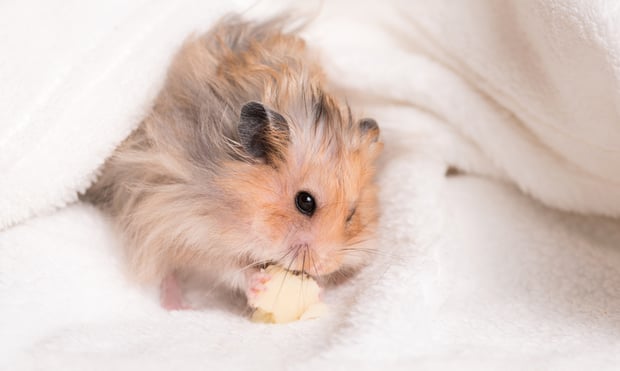
There are three “clues” that long-haired hamster owners can use to detect changes in condition:
- Changes in behavior
- Coat condition
- Changes in body weight
The Link Between A Long-Haired Hamsters Behaviour And Health
Although long-haired hamsters are not “wild” hamsters, they have retained the wild instinct of the wild-type Syrian hamster. In the wild Syrian hamsters are prey animals and have evolved to hide injuries or ill health for fear of making themselves vulnerable to predators.
Learning what normal behavior for your long-haired hamster is will allow you to notice subtle differences in your hamster behavior.
Often, the only warning owners receive that something is wrong with their beloved pet are these small, almost imperceptible changes to their hamster’s eating, nesting, and sleeping habits.
Long-Haired Hamsters’ Coat Condition Is Indicative Of Health
A healthy long-haired hamster’s coat should look and feel soft and cottony. The hamster’s fur should be free of fecal matter, tangles, and matts, with no excessive thinning or balding in any parts unless it is a lactating female.
Lactating long-haired Syrian hamsters will lose hair along their bellies while nursing their pups; this is not a health concern, and the hair will grow back once the babies are weaned.
Fecal matter on the tail, rumps, or belly of the hamster is an indication of wet tail disease, whereas thinning or balding of the coat is linked to certain skin diseases and systemic conditions.
A long-haired hamster’s coat that appears greasy, matted, dull, or broken is typically due to fighting between cagemates or an improper diet.
How To Monitor My Long-Haired Hamster’s Weight?
On average most long-haired Syrian hamsters should weigh slightly less than an ounce for every inch of length. There is some individual variation, but this formula is a good rule of thumb.
Merck’s Veterinary Manual states that the average length of a Syrian hamster is 6 to 8 inches (15 to 20 cm); therefore, according to the formula, long-haired Syrian hamsters should weigh between 4 to 8 oz (110 to 226 g).
Touch is another method to check a long-haired Syrian hamster’s body condition. Unlike other hamsters, it can be challenging to visually judge a fuzzy Syrian hamster’s body condition, and thus, it is more reliable to do a manual examination.
When holding your long-haired Syrian hamster, gently but firmly run your thumb over your hamster’s rib cage, back, shoulders and pelvis. In a healthy hamster, you should not be able to feel any skeletal definition; if you can feel your hamster’s bones, then they’re too thin!
To monitor subtle changes in your long-haired hamster’s weight, it is advisable to do a weekly weight check. Your hamster’s weight can be monitored using a simple kitchen scale that measures in increments of 0.1 oz with a minimum weight range of 2 to 16 oz.
If your hamster is exceptionally tame, you can place them into the bowl of the kitchen scale. Alternatively, you can put your hamster in a container and weigh the container and hamster together. However, it is essential to remember to deduct the weight of the container to find out what your long-haired hamster weighs.
Do Long-Haired Hamsters Have Special Dietary Requirements?
Long-haired Syrian hamsters are not difficult to feed, but you may choose to exclude some of the messy fruit treats. Some of the softer hamster-safe fruits like plum and banana can form a sticky residue that gets tangled in the coat of a long-haired hamster.
To prevent these problematic tangles and matts, it is better to avoid using these fruit treats. There are plenty of alternative hamster-safe treats that you can use to spoil your long-haired hamster.
Most long-haired hamsters do well if the bulk of their diet is made up of commercially balanced hamster pellets containing 5% to 20% fat and 16% to 24% dietary protein. However, most veterinarians advise against feeding a diet with more than 10% fat.
How To Keep A Long-Haired Hamsters’ Coat In Good Condition?
A long-haired hamster’s coat requires more care and consideration than a short-haired hamster’s.
Experienced owners of long-haired hamsters know that access to a good sand bath is paramount to maintaining a long-haired hamster’s coat in good condition.
Hamsters naturally secrete oil, and with time, the oil can build up and cause issues for your long-haired hamster. Not only does the oil make your hamster look like it got caught in an oil spill, but it also provides the perfect environment for fungal and bacterial infections.
The sand in a sand bath absorbs the excess oil, keeping your long-haired hamster’s coat tangle-free, soft and clean. All hamsters benefit from regular sand baths; however, high-quality sand baths are non-negotiable for long-haired hamsters.
Many owners are tempted to bathe and brush their long-haired hamsters. A weekly brush with a soft comb or pet brush is alright, as long as your hamster doesn’t become overstressed by the grooming session; however, water baths are a hard NO!
What Health Issues Do Long-Haired Hamsters Have?
Long-haired hamsters are susceptible to wet tail disease caused by Proliferative Ileitis.
Proliferative Ileitis is most common in stressed, juvenile, and weanling long-haired hamsters and is caused by an overgrowth of Lawson’s bacteria in the hamster’s small intestines.
Proliferative Ileitis causes inflammation in the small intestines, which in turn causes the hamster to have a watery diarrhea characterized by wet matted fur on the hamster’s tail, rump, and belly.
Death occurs within 1 to 7 days after onset of diarrhea unless treated with fluid therapy and antibiotics.
What Is The Ideal Temperature For Long-Haired Hamsters?
The ideal environment for long-haired hamsters:
- Temperature: 64 °F to 79 °F (17 °C to 26 °C)
- Humidity: 30% to 70%
Hamsters kept at temperatures below 60 °F, in low light conditions are more likely to start showing hibernation-type activity, although they will only hibernate at temperatures below 41 °F.
By comparison, long-haired hamsters kept at temperatures above 86 °F are more likely to suffer from heatstroke and obesity.
Do Long Haired Hamsters Like To Be Held?
Long-haired hamsters are not like dogs; they will not voluntarily seek human contact or physical affection. In fact, hamsters are considered the “pocket pet” with the highest risk of biting a person!
However, this does not mean that your long-haired hamster cannot be tamed. Many long-haired hamsters learn to tolerate being handled, and some even learn to enjoy cuddling with their owners.
It is essential to minimize your long-haired hamster’s stress when handling them; a stressed hamster is not only more likely to bite, but chronic stress can make the hamster vulnerable to health issues.
Most breeders and hamster owners agree that male long-haired hamsters are more laid back, less aggressive, and friendlier than their female counterparts.
Do Long-Haired Hamsters Need A Companion?
Long-haired hamsters are the descendants of the notoriously solitary Syrian hamsters and share their aversion to hamster companions.
Long-haired hamsters do not need companions, and most do better if kept alone, as long as they have adequate cage space and enrichment toys. Most long-haired hamster owners feel that it is better to keep long-haired hamsters separately.
What Is The Ideal Cage For Long-Haired Hamsters?
There is no consensus about the best size for a long-haired Syrian hamster’s cage.
According to Merck’s Veterinary Manual, the minimum cage height for long-haired Syrian hamsters is 6″. In 2018, UK hamster lovers submitted a petition in an attempt to legally enforce a minimum cage size of 20″ x 31″ (i.e., 620 in2) for long-haired Syrian hamsters.
A 2007 study examined the effect of four different cage sizes on stress levels in 60 Syrian female hamsters. The four cage sizes tested were:
- 10,000 cm2 ( 1,500 in2)
- 5,000 cm2 ( 775 in2)
- 2,500 cm2 ( 388 in2)
- 1,800cm2 ( 279 in2)
The scientists discovered that the hamster’s stress level negatively correlated with cage size, i.e., as cage size increased, the hamster’s stress level decreased.
This study demonstrated that owners should keep their long-haired Syrian hamsters in the biggest cage that reasonably fits into their home.
How Long Do Long-Haired Hamsters Live?
The lifespan of a long-haired Syrian hamster is determined by their:
- Genetics
- The quality of their care, including diet and cage space
- Duration, frequency, and severity of chronic and acute stress levels
- Health history
No long-haired hamsters live in the wild, as the mutation causing long-hair first occurred in captive-bred hamsters; thus, it is impossible to say how long a wild long-haired hamster would live.
However, long-haired hamsters are descendants of Syrian hamsters, and we know that Syrian hamsters in the wild have an average lifespan of 1.5 to 2 yrs.
In captivity, the average lifespan for a long-haired Syrian hamster is approximately 2yrs, with a few exceptionally long-lived individuals making it to 4yrs old.
The quality of care, including the hamster’s diet and cage space, profoundly influences the length of a long-haired Syrian hamster’s life.
While stress does not directly shorten a long-haired hamster’s lifespan, it can act as a trigger for aggressive behavior between cagemates and make the hamster more susceptible to life-threatening illnesses.
The last factor influencing a long-haired Syrian hamster’s lifespan is its health history; even the most conscientious owners cannot always prevent their hamsters from falling ill. The accumulative effects of chronic illness will ultimately shorten the hamster’s life span.
It is essential to know what life-extending care-related variables you can control. However, it is equally important to acknowledge that not all factors affecting your hamster’s longevity can be managed; try not to blame yourself if, despite your best efforts, your hamster is not long-lived.
Conclusion
Learning to care for a long-haired hamster is not difficult as long as you recognize that a few of a long-haired hamster’s care requirements differ because of its long fur.
Long-haired hamsters should be:
- Fed a balanced diet, free of excessively messy or wet fruit treats
- Have access to a high-quality sand bath
- Given a big enough cage
- Kept in a low-stress environment
References
https://animaldiversity.org/accounts/Mesocricetus_auratus/#lifespan_longevity
https://veterinarypartner.vin.com/default.aspx?pid=19239&catId=102923&id=9610265
https://www.ncbi.nlm.nih.gov/books/NBK231928/
https://academic.oup.com/jhered/article-abstract/64/4/236/787398
https://academic.oup.com/jhered/article-abstract/65/1/57/852070
https://research.fiu.edu/documents/facilities/acf/documents/hamster-biology-husbandry.pdf
https://www.msdvetmanual.com/exotic-and-laboratory-animals/rodents/hamsters
https://www.msdvetmanual.com/all-other-pets/hamsters/providing-a-home-for-a-hamster
